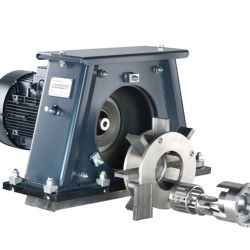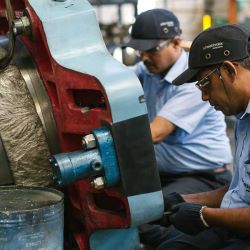A blast machine is a complex beast. Assessing its energy consumption behaviour to find room for improvement therefore isn’t as straightforward as it sounds.
With this exercise we wanted to systematically measure, evaluate and compare all the factors contributing to one machine’s energy consumption and efficiency. So, for several months in 2017, a Wheelabrator IBC-12/45-540-432, the trusted inclined belt conveyor concept, had special attention. Every nook and cranny of it.
First, meet the subject
In brief, the IBC range are continuous through-feed machines that treat workpieces individually. They are particularly suited to disc-shaped parts and are often used for blast-cleaning the disc-shaped part per se: the brake disc. It’s an efficient machine, designed for high-volume, high-quality production.
The approach: no stone unturned
To get the complete, real picture of the machine’s energy consumption behaviour, we took into account every single motor and drive of the various components, assessed their individual input power, behaviour and energy conversion efficiency, and looked at alternative specifications and operating parameters for each.
We measured the actual input power via a SIEMENS meter plugged in at the electric cabinet, taking readings every two seconds. All these data points were then fed into a specially adapted SPS software programme to analyse behaviour under varying operating conditions and calculate energy conversion coefficients.
When assessing energy conversion efficiency, it was important to really understand the role of each component in the operation of the machine. For example, drives on the abrasive recycling system show a very low energy conversion efficiency at normal fill levels, as they are deliberately over-engineered for normal operation. The simple reason: in the event of an unplanned machine stop, they have to be able to quickly restart an abrasive system with up to 200% the normal fill level.
Balancing acts
In other areas, we’ve found some of the most important gains can be made by looking at the energy efficiency of stand-by versus switch-off – i.e., when is it more beneficial to do one rather than the other? We systematically looked at energy use for stand-by and start-up for each component, as well as the speed of restarting. Here again, it’s a balancing act, as the logical interplay of components has to be taken into account.
Start-up times in general are an interesting topic and we’ve found room for improvement in the better orchestration of start-ups of different machine elements. For example, it can be beneficial to start one component group gently and couple it with the start-up of another group. In the case of the IBC, we’ve found a slow-start of the abrasive system synched with the start-up of the blast wheels to achieve faster and more energy-efficient ramp-up. The optimum way of starting up the blast wheels is in pairs, timed with the abrasive system start-up. We were able to show that an improvement in start-up time from 88 to 46 seconds is possible, making temporary switch-offs worthwhile more often.
Other findings
In addition to the optimisation of stand-by/switch-off and start-up phases, we’ve also found that it’s energetically more beneficial to run the machine at 75-100% capacity, using strategic switch-off of drives during periods of lower throughput. This means it is more efficient to run at high throughputs for a short period of time and then switch off until it is possible to run at high throughput again, rather than run continuously at low to medium throughput rates.
For the energy-efficient switch-off and restart of blast wheels during shorter periods of reduced throughput, we’ve examined and compared two options: soft starters and frequency converters. While the frequency converter option offered faster deceleration and start-ups of the wheels and allowed the restart of up to 6 wheels at once, it was four times as expensive as the soft starter. A switch-off with the latter option still enables a saving of 84% in stand-by energy, for a much lower initial investment.
The variability of workpieces is the biggest barrier to keeping the machine at 75-100% throughput, as the machine is specified for the workpiece that requires the maximum performance and will not be maxed out by other workpiece types, meaning it will run less efficiently.
Conclusion
There are many more observations and individual optimizations to talk about, but we wanted to simply give a flavour of the potential that can still be unlocked even in established machine concepts.
The systematic, holistic assessment of blast machine performance has shown that it is important to keep looking for optimisations in equipment, taking into account the specific practical and operational contexts the machine sits in, as well as the interplay of component groups.
The exercise has certainly taught a lot about the importance of tailoring equipment to individual production requirements – and the key role it can play in achieving sustainable production.


